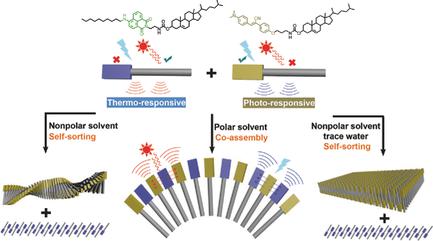Our official English website, www.x-mol.net, welcomes your
feedback! (Note: you will need to create a separate account there.)
Environment‐Adaptive Coassembly/Self‐Sorting and Stimulus‐Responsiveness Transfer Based on Cholesterol Building Blocks
Advanced Science ( IF 14.3 ) Pub Date : 2017-11-08 , DOI: 10.1002/advs.201700552 Pengyao Xing 1 , Huijun Phoebe Tham 1 , Peizhou Li 1 , Hongzhong Chen 1 , Huijing Xiang 1 , Yanli Zhao 1, 2
Advanced Science ( IF 14.3 ) Pub Date : 2017-11-08 , DOI: 10.1002/advs.201700552 Pengyao Xing 1 , Huijun Phoebe Tham 1 , Peizhou Li 1 , Hongzhong Chen 1 , Huijing Xiang 1 , Yanli Zhao 1, 2
Affiliation

|
Manipulating the property transfer in nanosystems is a challenging task since it requires switchable molecular packing such as separate aggregation (self‐sorting) or synergistic aggregation (coassembly). Herein, a unique manipulation of self‐sorting/coassembly aggregation and the observation of switchable stimulus‐responsiveness transfer in a two component self‐assembly system are reported. Two building blocks bearing the same cholesterol group give versatile topological structures in polar and nonpolar solvents. One building block (cholesterol conjugated cynanostilbene, CCS) consists of cholesterol conjugated with a cynanostilbene unit, and the other one (C10CN) is comprised of cholesterol connected with a naphthalimide group having a flexible long alkyl chain. Their assemblies including gel, crystalline plates, and vesicles are obtained. In gel and crystalline plate phases, the self‐sorting behavior dominates, while synergistic coassembly occurs in vesicle phase. Since CCS having the cyanostilbene group can respond to the light irradiation, it undergoes light‐induced chiral amplification. C10CN is thermally responsive, whereby its supramolecular chirality is inversed upon heating. In coassembled vesicles, it is interestingly observed that their responsiveness can be transferred by each other, i.e., the C10CN segment is sensitive to the light irradiation, while CCS is thermoresponsive. This unprecedented behavior of the property transfer may shine a light to the precise fabrication of smart materials.
中文翻译:

基于胆固醇构建基团的环境适应性联合装配/自我选择和刺激反应性转移
操纵纳米系统中的特性转移是一项艰巨的任务,因为它需要可切换的分子堆积,例如单独的聚集(自分选)或协同聚集(共组装)。在此,报道了在两个组件的自组装系统中进行自排序/共组装聚合的独特操作以及对可切换的刺激响应传递的观察。带有相同胆固醇基团的两个构件在极性和非极性溶剂中具有多种拓扑结构。一个结构单元(胆固醇共轭氰基二苯乙烯,CCS)由与氰基苯乙烯基共轭的胆固醇组成,另一种(C 10CN)由与具有柔性长烷基链的萘二甲酰亚胺基连接的胆固醇组成。获得了它们的组件,包括凝胶,结晶板和囊泡。在凝胶和结晶板相中,自分选行为占主导,而在囊泡相中则发生协同共组装。由于具有氰基二苯乙烯基团的CCS可以响应光辐射,因此会经历光诱导的手性扩增。C 10 CN具有热响应性,因此其超分子手性在加热时逆转。在共组装的囊泡中,有趣地观察到它们的反应性可以彼此转移,即C 10CN段对光照射敏感,而CCS对热敏感。财产转移的这种前所未有的行为可能会为智能材料的精确制造提供启示。
更新日期:2017-11-08
中文翻译:

基于胆固醇构建基团的环境适应性联合装配/自我选择和刺激反应性转移
操纵纳米系统中的特性转移是一项艰巨的任务,因为它需要可切换的分子堆积,例如单独的聚集(自分选)或协同聚集(共组装)。在此,报道了在两个组件的自组装系统中进行自排序/共组装聚合的独特操作以及对可切换的刺激响应传递的观察。带有相同胆固醇基团的两个构件在极性和非极性溶剂中具有多种拓扑结构。一个结构单元(胆固醇共轭氰基二苯乙烯,CCS)由与氰基苯乙烯基共轭的胆固醇组成,另一种(C 10CN)由与具有柔性长烷基链的萘二甲酰亚胺基连接的胆固醇组成。获得了它们的组件,包括凝胶,结晶板和囊泡。在凝胶和结晶板相中,自分选行为占主导,而在囊泡相中则发生协同共组装。由于具有氰基二苯乙烯基团的CCS可以响应光辐射,因此会经历光诱导的手性扩增。C 10 CN具有热响应性,因此其超分子手性在加热时逆转。在共组装的囊泡中,有趣地观察到它们的反应性可以彼此转移,即C 10CN段对光照射敏感,而CCS对热敏感。财产转移的这种前所未有的行为可能会为智能材料的精确制造提供启示。











































 京公网安备 11010802027423号
京公网安备 11010802027423号